Wed 16 Mar 2011
by Curt J. Evans
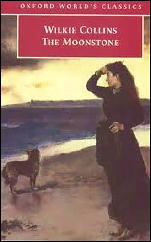
Anna Katharine Green’s milestone American detective novel, The Leavenworth Case (1878), was reprinted last year in an attractive new edition as part of the Penguin Classics series, which now puts the tale in the company of such distinguished nineteenth-century works with detection and sensation elements as Charles Dickens’ Bleak House (1853), Mary Elizabeth Braddon’s Lady Audley’s Secret (1862) and Wilkie Collins’ The Moonstone (1868).
“Some critics disparage [Green’s] characters’ occasional florid speeches” in The Leavenworth Case, admits Michael Sims in his Introduction to the new edition of the tale. Nevertheless Sims contends that while “now and then [Green’s] storytelling [in The Leavenworth Case] is as leisurely as you would expect from a nineteenth-century novel,” the author “keeps the dialogue lively and mostly convincing.”
I would have to dispute Sims’ contention. Except in the effective portrayal of the archetypal “nosey spinster” character, Amelia Butterworth (who appears in three later Green mystery novels), lively and convincing dialogue did not flow easily from the pen of Anna Katharine Green. Indeed, during the numerous high stress situations in Leavenworth, the dialogue, which is never memorable, becomes positively purple (and therefore false), as the character prate like bad stage actors in fifth-rate melodramas:
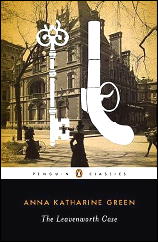
Put simply (as she herself too infrequently put things), Anna Katharine Green was not a scintillating writer. To get to the puzzle plots in her tales, one must wade through shoals of prose that ranges from the merely tedious to the truly tiresome. Even forty years after Leavenworth, as the Twenties roared just around the corner (and with it the Golden Age of detective fiction), Green, in The Mystery of the Hasty Arrow (1917) continued to write unattractively and unpersuasively:
and:
And Green’s characters still have a pronounced tendency to orate, rather than speak naturally, as real-world human beings:
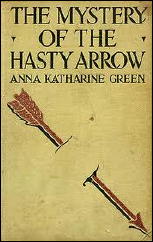
I found Arrow too dully written to bear with over its great length (despite some excellent “multimedia” floor plans that are like something out of one of S. S. Van Dine’s Philo Vance murder cases), yet I wondered about Michael Sims’ implication that the leaden prolixity of Green’s writing simply reflected her literary age. For my part, I certainly had not remembered Charles Dickens and Wilkie Collins being unable to sketch appealing, believable characters.
So for purpose of this review I decided to read three fairly short “sensationalist” works by three Victoran authors: Mary Elizabeth Braddon’s “The Mystery at Fernwood”(1862), Wilkie Collins’ “Who Killed Zebedee?” (1881) and Benjamin Leopold Farjeon’s Devlin the Barber (1888).
In each case I found that, while, the works offered nothing in the way of the more complex detection found in the tales of Anna Katharine Green, nevertheless they each contrastingly offered believable characters and emotionally compelling situations and as a result were vastly more enjoyable to read.
“The Mystery at Fernwood” and “Who Killed Zebedee?” are long short stories (about forty and twenty-five pages, respectively; the latter is also known, more prosaically, as Mr. Policeman and the Cook).
In “Fernwood” Mary Braddon effectively mines the Gothic tradition that had been first struck in Horace Walpole’s The Castle of Otranto (1764) and that perhaps produced it richest early lode of ore with Ann Radcliffe’s The Mysteries of Udolpho (1794). In many of Braddon’s verbose triple-decker sensation novels, appealing mystery elements are too much submerged in love stories (see, for example, Wyllard’s Weird, 1885), but that is not so with the lean and spare Fernwood.
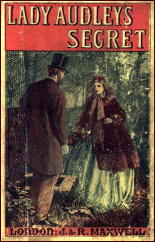
In this tale, a young woman finds not only mystery but grave menace when she visits Fernwood, the decaying Yorkshire country estate of her fiancee. “No, Isabel, I do not consider that Lady Adela seconded her son’s invitation at all warmly,” fatefully announces the heroine’s aunt in the first line of the story.
Academics might strain hard with this tale to find deep meaning about the position of women in Victorian England, but I do not see it myself. However, “Fernwood” is a rattlingly suspenseful tale (even if you pierce the veil of the mystery quickly, as you probably will) and a fine example of the grand and hallowed Gothic tradition that has extended right up to this day in such mystery genre works as Barbara Vine’s The Minotaur (2005).
Wilkie Collins’ “Who Killed Zebedee?” at first seems, with its title and its setting (a lodging house full of eccentric characters), to have popped straight out of the Golden Age of the detective novel (1920-1939), rather than the Victorian era. A frantic cook bursts into a police station, armed with a doleful tale of murder at the lodging house in which she is employed. The victim is one John Zebedee, who was stabbed to death in his bed.
Suspicion immediately falls on Zebedee’s wife, a somnambulist. People fearing a repetition of another Wilkie Collins tale will be pleased to see other suspects emerge among the company of lodgers, most obviously the dandified Mr. Deluc. Desirous of helping the law is the nosy elderly spinster Miss Mybus, yet another interesting early incarnation of a character type most strongly associated today with Agatha Christie’s Miss Marple.
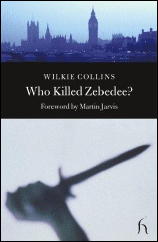
The attention to police procedure and the thumbnail character sketches in “Zebedee” are quite good, making one wish that the tale had been expanded into a full-length novel. As it stands,”Zebedee” is a disappointment as a tale of detection, with the solution coming essentially fortuitously.
To be blunt, “Zebedee” is more luckstone than Moonstone. Collins is more interested here in exploring character, however, and he does this very well, even providing a surprisingly ambivalent ending in the modern fashion.
The only novel among these three works is Devlin the Barber, a striking admixture of mystery and horror elements authored by the prolific novelist Benjamin Farjeon (father of the beloved children’s book writer Eleanor Farjeon).
Luridly advertised on London billboards with an illustration of a young woman bloodily stabbed by a seeming maniac, the book appeared the same year as the Jack the Ripper serial killings horrified England (what are considered to be the genuine Ripper murders took place in 1888 between the dates of August 31 and November 9; Farjeon’s work appeared in serial and book form later that year). Devlin the Barber seems quite obviously to draw not only on the Ripper killings but the gruesome legend of Sweeney Todd, the demon barber.
Devlin the Barber was called a “disagreeable but certainly ingenious tale” when it first appeared and since then has customarily been deemed the best of Farjeon’s many fictional works (only a few of which were sensationalist). Three years before the appearance of Devlin, Farjeon had written Great Porter Square (1885), the first of several praised mystery novels. The man clearly had a talent for crime writing, even though Devlin surely to an extent has to be seen as an opportunistic effort (if an inspired one).
Despite its clear linkage with Jack the Ripper, Devlin opens with only one slaying, that of a nice, middle class young woman who for some reason was keeping a secret late-night rendezvous. After she is found fatally stabbed, it is learned that her twin sister (twins were quite popular in crime books before the Golden Age) has disappeared.
The young ladies’ wealthy uncle, lately returned from Australia, for no particularly compelling reason offers the narrator of the tale, an out-of-work, middle-class friend of the family, a grand sum to solve the case (naturally he has no faith in the police).
The narrator soon finds that the murdered woman had a gentleman friend, but he seems like a winning young man (he is even wealthy and has a responsible guardian). The most striking event occurs, however, when the narrator is called upon for help by his former nursemaid, Mrs. Lemon (could this have been the mother of Hercule Poirot’s future secretary — I certainly hope so). It seems Mrs. Lemon has a very odd lodger indeed, a barber named Mr. Devlin….
Mrs. Lemon’s tale of her frightening lodger, which takes up over a fourth of the book (fifty of the Arno Press edition’s 190 pages), is a tour de force of horror narration. It is almost a disappointment when we come back to the mystery investigation. But now we have a new investigator of the heinous murder: Mr. Devlin himself! If you thought this novel was going to take the same turn of events as Marie Belloc Lowndes’ famous Ripper tale, The Lodger (1913), think again.
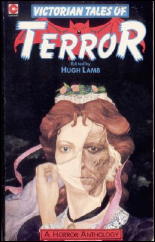
More could be said about this fascinating novel, but I will leave the reader to seek out the book for him/herself. I will simply add that, in contrast with The Leavenworth Case, the narrative throughout Devlin the Barber (published ten years later) is smooth and idiomatic, a reader’s delight. Even the cry of the murdered woman’s beloved is not nearly so melodramatic as the contrived speeches you find in Leavenworth:
The long narrative of Mrs. Lemon is especially fine. Like the better-known Braddon and Collins, Farjeon was an effective spinner of tales.
Anyone wanting a good murder story from the Victorian era is advised to seek out these works by Mary Braddon, Wilkie Collins and Benjamin Farjeon. They may be old, but they still speak to us today. During the last decade “The Mystery at Fernwood” and “Who Killed Zebedee?” have been reprinted in attractive editions by Hesperus Press, an admirable publisher of shorter literary classics. (The former has also been collected several times, including in Victorian Tales of Terror, edited by Hugh Lamb, as shown.)
Devlin the Barber, however, stands in need today of a modern scholarly edition (the 1978 Arno Press reprint edition itself is now a rare and valuable collector’s item). Perhaps Penguin Classics will heed the call.
March 16th, 2011 at 6:32 pm
Green is historically important, but I doubt anyone could read her for pleasure alone. Her dialogue is only a little better than that found in Penny Dreadful and the H’apenny Press efforts — and at least those have a certain charm to them I find lacking in Green.
As you say the same isn’t true for Collins or Braddon, and I hope to eventually find the Farejon after your review. Perhaps, if nothing else, it will show up online.
I suppose the surprise for most readers is just how well the best Victorian writers read. Admittedly the novels can be leisurely compared to modern standards, but the short fiction and novellas are often well written and effective.
It will be a pity if Green becomes the poster child for the Victorian sensation novel merely because she sailed a bit closer to the classic detective novel than some others. I pity someone who doesn’t know the genre and is mislead into thinking Green is the best it had to offer. She is historically important and for that should be in print and appreciated, but she was not someone most modern readers can read for pleasure — not when there are much better writers out there who don’t require half as much effort to read or enjoy.
As a writer Green never missed a cliche, a clunker, or the chance to declare when her characters should simply be speaking. Reading her work you have to think she attended a good deal of really bad theater when she was writing.
March 16th, 2011 at 6:45 pm
Curt, great review of four 19th Century mysteries.
But I wonder if one need to be a good writer to be an important one. What makes Green “important” today is that she influenced the coming generation that would give us the classic age of mystery. To me, one should not read Green looking for great mystery, but instead read her through Agatha Christie’s eyes. What was it about THE LEAVENWORTH CASE that appealed to readers such as Christie? I’d like to think Christie figured if Green could get published so could she.
As for the current fad to immortalize Green, if everything has all ready been written about Christie, then any academic, in their publish or perish world, will naturally turn to who inspired Christie and others of the Classic area.
None of this distracts from your great review of four books from an era when the mystery genre was just beginning.
March 16th, 2011 at 7:37 pm
Michael, I’m really fine that Penguin Classics has reprinted Green (not that they are worried about what I think!). What I really hope though is that this opens the field to other writers who also were important within the mystery genre (and who were arguably better writers).
I wish the “publish or perish” world of academia would inspire a lot more research on other writers, but so far the favored areas remain the Poe and Doyle, the hardboiled, the Crime Queens and the Victorian sensation novel (particularly when authored by women). The presence of an interest on the part of academic publishers in other areas is, I believe, a postulate that is open to dispute.
Norman Donaldson’s book on the fascinating R. Austin Freeman was originally published forty years ago, I believe. Freeman’s books were reprinted by House of Stratus, to be sure, but I await the appearance of The Red Thumb Mark, say, in a Penguin Classics edition. The same could be said for Freeman Wills Crofts’ The Cask, another influential book (Crofts is no great writer, but then neither is Green in The Leavenworth Case).
I also am kind of surprised to think that claims are being made for Green as an exceptional prose stylist, particularly in The Leavenworth Case. I’m dubious. Good prose style should involve something more than the heavyhanded expression of melodrama. Not that Green has not (yet) been raised up to Collins’ level, but there is quite a yawning gap in literary skill between the two, imo (to be fair to Green, Collins is at the top of the hill).
I wrote this piece in part as a way to test Sims’ contention that Green’s heavyhanded melodrama in Leavenworth is simply the product of the era in which she wrote. I don’t think it is. I think she lacks the writing ability of Collins, or Le Fanu or Braddon or Farjeon.
I really was struck how the characters in Devlin, for example, were able to converse, only ten years after Leavenworth, with complete naturalness for this reader, who was born nearly eighty years after Devlin first appeared.
David:
Do you recall the scene in the Martin Scorsese film version of Edith Wharton’s The Age of Innocence, where Newland Archer goes to see the bad (but hugely popular) melodramatic play? It reminded me of several scenes in The Leavenworth Case. I feel sure Green must have been in the audience.
Where Green really deserves credit, of course, is in raising the detective interest in the novel up to a higher level, but her new supporters now are making claims beyond that.
March 16th, 2011 at 7:42 pm
Michael
You certainly don’t have to be good to be important, and I don’t think anyone is arguing that Green shouldn’t be read. But she shouldn’t be portrayed as a great writer either.
Ross Macdonald admitted to being influenced by Nelson Lee and Falcon Swift — do we have to praise them (well, I’d rather read Nelson Lee or Falcon Swift than Green)?
Writers like everyone else have favorites who aren’t always great literature. P. G. Wodehouse was particularly fond of his friend Sax Rohmer’s books, Dorothy Sayers liked Sexton Blake so much she tried to write one. No few important women writers in the genre have fond memories of Nancy Drew.
No one wants to deny Green her historical position or importance — Bulwer Lytton is important too — dark and stormy night and all (and even he is a far better writer than Green), but I do think it is more than fair to point out that the recent elevation of Green tries to ignore the fact she isn’t a good writer by any standard.
After all Mark Twain’s famous attack on Fenimore Cooper doesn’t seem to have done much damage to the countless editions of LAST OF THE MOHICANS printed since.
Green falls into that category. No one wants to deny her the place she deserves in the pantheon — just to warn people that she’s more important from a historical perspective than an entertainment one.
March 16th, 2011 at 7:54 pm
Curt
The scene in AGE OF INNOCENCE does indeed remind me of Green. That and some of the hoarier old Todd Slaughter films of famous barn burners — save Slaughter makes them interesting, Green’s prose just tends to stop things dead.
The problem with scholarship is that too often it has an aggenda other than critical appreciation. For some reason a group of critics has chosen Green to elevate to a position her influence may deserve, but her prose does not.
Green is only a little better than the penny press prose of the day with the exception of her structure and plot elements. There she is very important to the development of the detective novel.
I don’t see why her historical import can’t be written about without trying to claim some quality her writing does not deserve? I suppose next they will be trying to tell us Lady Caroline Lamb was a better writer than Byron.
March 16th, 2011 at 8:24 pm
Curt, David, I agree with both of you. I just wonder what Christie and others of that era enjoyed about Green.
March 16th, 2011 at 9:11 pm
Wilkie Collins liked The Leavenworth Case too, to be fair (as least that’s what I’ve read). But T. S. Eliot went back and read it in 1929, about thirty years after he read it originally (apparently he first read it when he was about twelve–he was born two years before Christie) and was inspired to write an essay about why Green didn’t hold up as well as Doyle (and she doesn’t, imo).
The prime minister Stanley Baldwin, on the other hand, thought Leavenworth one of the greats, which inspired Symons’ crack about the bad taste of politicians.
I wouldn’t be surprised that Green made an impact on the young Christie (she did on Carolyn Wells too). She may even have liked the emotional melodrama. Styles has some Green-ish aspects (though neither of Christie’s major biographers mention Green?).
And nineteenth-century melodrama seems to be finding an audience again today. After all, East Lynne has been reprinted by Oxford University Press as well. On amazon.co.uk it has twelve reviews: nine five-star and three four-star. The Big Sleep has twenty: fourteen five-star, three four-star, two three-star and one two-star.
March 16th, 2011 at 9:15 pm
Michael
Christie probably responded to the plotting, and possibly the spinster sleuthing. And as I said all writers have influences who are less than sterling.
Writers tend to be omnivorous readers, especially in their youth, and often as not they have favorites who influence them. John Buchan loved E. Phillips Oppenheim and Graham Greene admitted in an essay to liking Edgar Wallace more than Hugh Walpole (all those better than Green by leagues).
Green is important to the genre, but her importance should be limited to what she actually did and not to some quality acadmics seeking to further their careers by elevating her have invented for her.
Hers was not the standard by which sensation novels of the age should be judged.
March 17th, 2011 at 7:35 am
“And her eyes, fixed upon space, showed depths of horror hardly to be explained even by the suddenness and startling character of the untoward fatality of which she had just been made the unhappy witness.”
Anna Katharine Green, precursor to H.P. Lovecraft?
March 17th, 2011 at 2:34 pm
LOL, Xavier. It really would have enlivened The Mystery of the Hasty Arrow considerably had Yog-Sothoth or some such creature been loose in the museum, dragging people off to their slimy, tentacled deaths.
January 16th, 2020 at 9:10 am
[…] that didn’t know better are forgiven for their sins. Anna Katharine Green may have written in a way that overflowers Lovecraft but it’s okay because she « was of her time ». Who knows, perhaps HPL […]